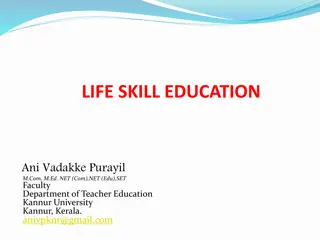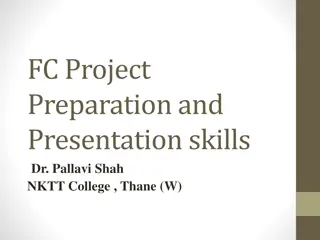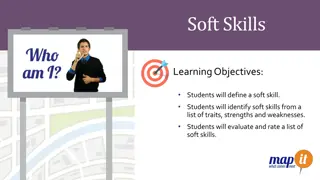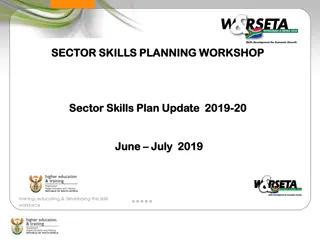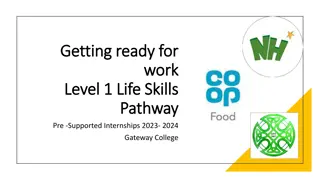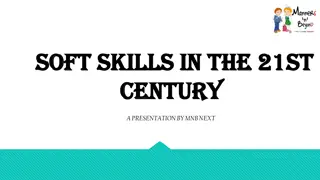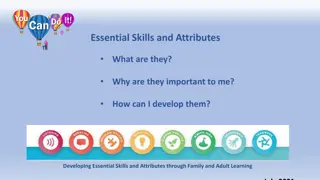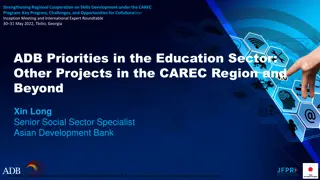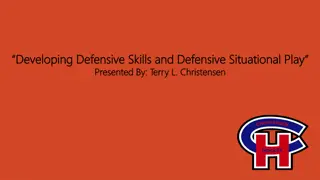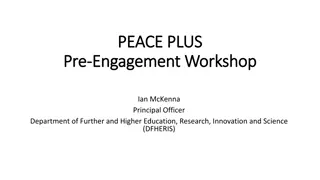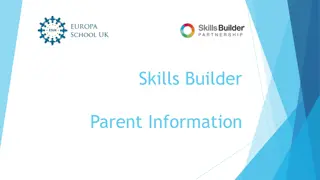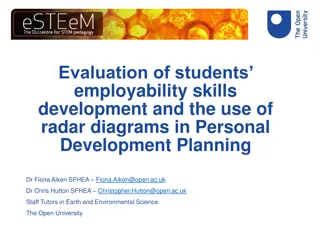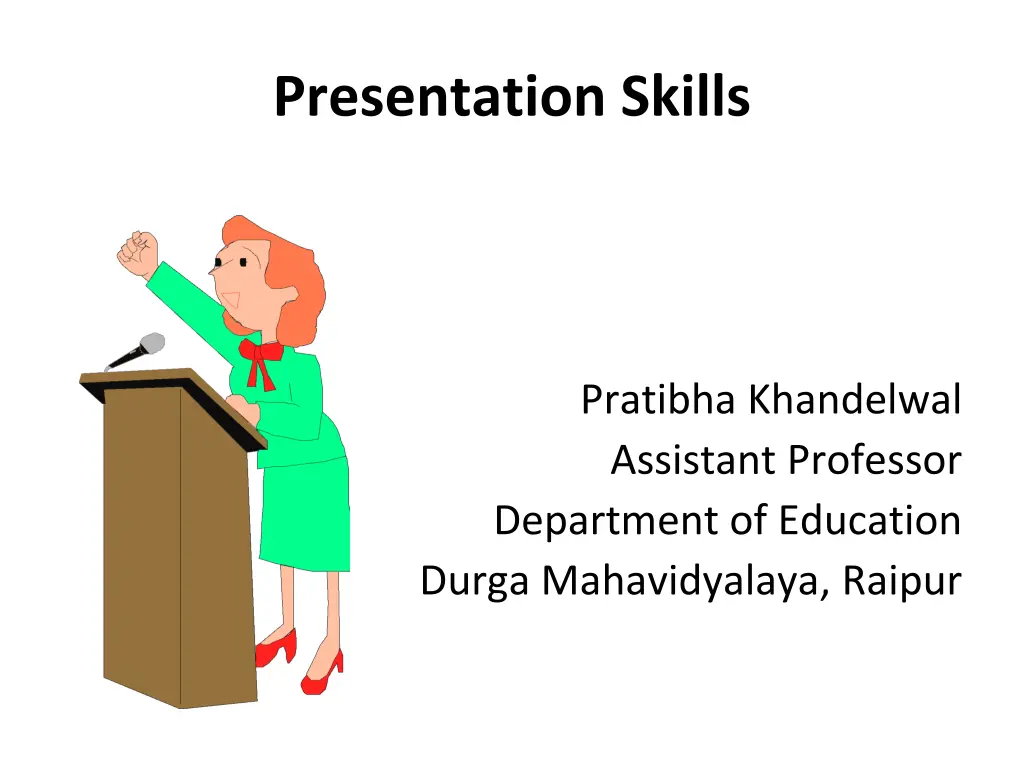
Effective Presentation Skills for Engaging Audiences in Education Settings
Discover the meaning of presentations, essential elements, planning strategies, and designing tips for effective communication with audiences. Learn how to captivate attention, organize content, and utilize audio-visual aids to enhance your presentations.
Download Presentation

Please find below an Image/Link to download the presentation.
The content on the website is provided AS IS for your information and personal use only. It may not be sold, licensed, or shared on other websites without obtaining consent from the author. If you encounter any issues during the download, it is possible that the publisher has removed the file from their server.
You are allowed to download the files provided on this website for personal or commercial use, subject to the condition that they are used lawfully. All files are the property of their respective owners.
The content on the website is provided AS IS for your information and personal use only. It may not be sold, licensed, or shared on other websites without obtaining consent from the author.
E N D
Presentation Transcript
Presentation Skills Pratibha Khandelwal Assistant Professor Department of Education Durga Mahavidyalaya, Raipur
Main topics Meaning of presentation Elements of presentation Planning a presentation Designing a presentation Practicing before presentation Arrangements before presentation Making presentation Features of good presentation Effective body language Audio-visual communication
MEANING OF PRESENTATION Presentation means speaking on a topic before a selected audience on some formal occasion. Presentation is a formal talk addressed to selected audience and presents ideas or information in clear structured way. It is any audio or visual way of communication with an aim to deliver a message to the audience.
ELEMENTS OF PRESENTATION Presenter Audience Content to achieve purpose
PLANNING A PRESENTATION Making presentation is an art and requires planning. M.M. Monipally (2001) has explained presentation planning in terms of 5 ws. Why ( to inform, educate, empathize, influence, convince) Who(age, sex, education level, status etc) Where (size of hall, number of audience, arrangements) When(time and duration of presentation) What (content of presentation)
DESIGNING A PRESENTATION It is the most tedious task and the ideas and points to be conveyed needs to be given a proper format, so as to make acceptable and comprehensible to the audience. A presentation should be structured as Introduction Main body Conclusion Question-answer session
INTRODUCTION An effective introduction is must to arouse interest and curiosity in audience. It also helps the presenter to capture attention and develop rapport with audience. Presenter can relate an incident, tell a story, quote an imminent person, ask question, give statistics and use other tactics to introduce a topic.
MAIN BODY Main body of presentation consists of key ideas, facts, figures and supporting materials. Presenter should select and arrange the materials in right sequence depending upon the objective of presentation and type of audience. One should always try and proceed from easy to difficult, acceptable to unacceptable and main to sub points.
CONCLUSION It is the last chance to sell the idea and leaves the final impression. So, it must be well planned and well delivered. It should generate the last thought in the minds of the listeners regarding the issues taken up in the speech and it should also make clear to audience as to what they should do next. Presenter can summarize main points or make a promise. One can also end with question and answer session.
QUESTION AND ANSWER SESSION Encourage the participants to ask questions. Listen to questions carefully and answer them. Tactfully edit the repeated questions. If you don t know the answer don t misguide.
PRACTICING BEFORE PRESENTATION Some possible practice techniques are : Avoid reading or memorizing Rehearse out loud and on your feet Memorize your introduction, conclusion and main transitions. Concentrate on your introduction Practice with your visuals Simulate the situation Improve your delivery Time yourself
ARRANGEMENTS BEFORE PRESENTATION Check the room arrangements Check the lighting and ventilation Check your visual aids Test all the equipments Test the readability of your slides Set up your notes and other things Arrange the space and objects around you (height and distance) Get comfortable with place & audience Relax physically and mentally
MAKING PRESENTAION Make effective use of body language. Use positive words and connect to the audience. Speak with required loudness, pitch, pace . Speak with correct pronunciation and expression. Speak to motivational listeners. Concentrate on here and now. Forget how you look and sound. Forget your own mistakes and stumbles. Use audio-visual aids.
FEATURES OF GOOD PRESENTATION Preparation and mastery Suitable language Right content An effective opening and closing Logical arrangement of main points Brevity and precision Lively delivery with humour Audience participation Using audio-visual aids Appropriate seating arrangements Effective use of body language
EFFECTIVE BODY LANGUAGE Body language is a form of non-verbal communication that supplements verbal communication. Some elements of body language are Posture Hand and arm gestures Body movements Eye contact Facial expression Pauses
Audio-visual communication(1) We remember through the senses 20% of what we hear = Audio sense 30% of what we see = Visual sense 50% of what we hear and see = Audio-Visual sense 80% of what we say = Work sense 90% of what we say and do = Multisensory task In audio-visual communication one tries and facilitates both audio and visual sense while presenting an idea, so as to make presentation interesting, attractive, vivid stimulating and effective.
Audio-visual communication(2) Types of audio-visual aids 1. Audio aids (radio, CDs, tape recorders .) 2. Visual aids (pictures, charts, maps, models , OHP ) 3. Audio-visual aids(computers, LCD, television ) Importance of audio-visual aids 1. Helps to catch and hold attention. 2. Increases retention of the audience. 3. Facilitates understanding. 4. Provides reinforcement. 5. Helps in developing perception of audience. 6. Saves time and energy. 7. Makes presentation interesting, vivid and effective.
Audio-visual communication(3) Techniques to make audio-visual communication effective are 1.Materials should be easy to understand. 2.Materials should be interesting. 3.Materials should arouse imagination of the audience. 4.Materials should be well synchronized. 5.Language of the audio material should be flawless. 6.The status and cultural background of the audience should be taken care while choosing the aids. Audio visual aids are not the substitutes but supplement.
Audio-visual communication(3) Techniques to make audio-visual communication effective are 1.Choose suitable place and time for display. 2.When not in use, keep the equipments switched off. 3.Use economical aids. 4.Aids should be adopted to the intellectual maturity of the audience. 5.In visual aids color chosen should be good and clear. 6.Use aids only if required don t forcefully fit them Audio visual aids are not the substitutes but supplement.
Questions asked in examination What all factors should be kept in mind to make the presentation effective? What role does body language play in making an oral presentation effective? What are the different factors one has to be sensitive to, for effective presentation? Write short notes on audio-visual aids and body language? Describe the principles of oral presentation. What factors would you bear in mind while going for an oral presentation before a large group? What do you understand by audio-visual communication? What are the skills a person should possess for effective presentation? Importance of audio-visual aids in presentation, give some examples? 1. 2. 3. 4. 5. 6. 7. 8.


